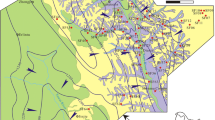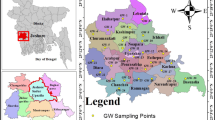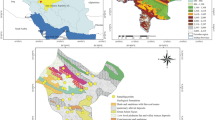Abstract
This study was carried out to investigate the current status of groundwater quality in Wuqi County, northwest China. The health risk assessment was also performed to quantify the negative impacts of hexavalent chromium (Cr6+) and nitrate (NO3−) in groundwater on human health by fully considering the gender and age of local residents. For this study, thirty groundwater samples were collected from wells and boreholes distributed in the study area and analyzed for pH, total dissolved solids (TDS), total hardness (TH), major ions (Na+ + K+, Ca2+, Mg2+, HCO3−, SO42−, and Cl−), NO3−, nitrite (NO2−), and Cr6+. Statistical analysis and graphical approaches were adopted to delineate the physicochemical parameters and hydrochemistry of groundwater. Fuzzy comprehensive method was applied in this study to appraise overall groundwater quality. The model recommended by the Ministry of Environmental Protection of the People's Republic of China was selected to assess the non-carcinogenic and carcinogenic risks caused by Cr6+ and NO3− through drinking water intake. Indicated by statistical mean values, the order of cations is Na+ + K+ > Ca2+ > Mg2+, and that of anions is SO42− > Cl− > HCO3−. The averages of TH, TDS, NO3−, and NO2− are 432, 1253, 23.2, and 0.099 mg/L, respectively. Piper diagram indicates that groundwater in the study area is SO4·Cl–Na type, SO4·Cl–Ca·Mg type, and HCO3–Na type. Gibbs diagrams suggest that the major ion chemistry of groundwater in the area is governed by rock weathering and water–rock interaction, while evaporation plays a minor role. According to the results of groundwater quality assessment, over one-third (36.67%) of the groundwater samples are of poor or very poor quality. Through oral pathway, female and male adults in the study area face acceptable non-carcinogenic risks, while children face unacceptable non-carcinogenic risks caused by Cr6+ and NO3−. Both children and adults face unacceptable carcinogenic risks from Cr6+. In addition, children face higher carcinogenic risks than females and males owing to smaller body weight than adults. This study may provide local authorities with insights into making scientific decisions for sustainable groundwater exploitation and efficient groundwater environmental protection.






Similar content being viewed by others
References
Alam MO, Shaikh WA, Chakraborty S, Avishek K, Bhattacharya T (2016) Groundwater arsenic contamination and potential health risk assessment of Gangetic plains of Jharkhand, India. Expo Health 8(1):125–142. https://doi.org/10.1007/s12403-015-0188-0
Busico G, Kazakis N, Colombani N, Mastrocicco M, Voudouris K, Tedesco D (2017) A modified SINTACS method for groundwater vulnerability and pollution risk assessment in highly anthropized regions based on NO3 − and SO4 2− concentrations. Sci Total Environ 609:1512–1523. https://doi.org/10.1016/j.scitotenv.2017.07.257
Cai W (1999) Extension theory and its application. Chin Sci Bull 44(17):1538–1548. https://doi.org/10.1107/BF02886090
Dahiya S, Singh B, Gaur S, Garg VK, Kushwaha HS (2007) Analysis of groundwater quality using fuzzy synthetic evaluation. J Hazard Mater 147(3):938–946. https://doi.org/10.1016/j.jhazmat.2007.01.119
General Administration of Quality Supervision, Inspection & Quarantine of China, Standardization Administration of China (2017) Standards for groundwater quality (GB/T 14848-2017). Standards Press of China, Beijing. (in Chinese)
Gibbs RJ (1970) Mechanisms controlling world water chemistry. Science 17:1088–1090. https://doi.org/10.1126/science.170.3962.1088
Gu X, Dang X, Yang B, Chang L, Li X, You X, Wang H, Wang Q (2015) The distribution regularity and sources of six-valence chromium in groundwater from Wuqi County, Yanan City. Northwest Geol 48(4):190–203. (in Chinese)
He Y, Dai A, Zhu J, He H, Li F (2011) Risk assessment of urban network planning in China based on the matter-element model and extension analysis. Electr Power Energy Syst 33:775–782. https://doi.org/10.1016/j.ijepes.2010.12.037
Kiurski-Milošević JŽ, Vojinović-Miloradov MB, Ralević NM (2015) Fuzzy model for determination and assessment of groundwater quality in the city of Zrenjanin. Serbia. HemijskaIndustrija 69(1):17–28. https://doi.org/10.2298/hemind131215016k
Li P, Qian H (2018a) Water resources research to support a sustainable China. Int J Water Resour Dev 34(3):327–336. https://doi.org/10.1080/07900627.2018.1452723
Li P, Qian H (2018b) Water in loess. In: Meyers RA (ed) Encyclopedia of sustainability science and technology. Springer, New York, pp 1–17. https://doi.org/10.1007/978-1-4939-2493-6_968-1
Li P, Qian H, Wu J, Zhang Y, Zhang H (2013) Major ion chemistry of shallow groundwater in the Dongsheng coalfield, Ordos Basin, China. Mine Water Environ 32:195–206. https://doi.org/10.1007/s10230-013-0234-8
Li P, Wu J, Qian H, Qian H, Lyu X, Liu H (2014a) Origin and assessment of groundwater pollution and associated health risk: a case study in an industrial park, northwest China. Environ Geochem Health 36:693–712. https://doi.org/10.1007/s10653-013-9590-3
Li P, Qian H, Wu J, Chen J, Zhang Y, Zhang H (2014b) Occurrence and hydrogeochemistry of fluoride in alluvial aquifer of Weihe River, China. Environ Earth Sci 71(7):3133–3145. https://doi.org/10.1007/s12665-013-2691-6
Li P, Li X, Meng X, Li M, Zhang Y (2016a) Appraising groundwater quality and health risks from contamination in a semiarid region of northwest China. Expo Health 8:361–379. https://doi.org/10.1007/s12403-016-02050-y
Li P, Zhang Y, Yang N, Jing L, Yu P (2016b) Major ion chemistry and quality assessment of groundwater in and around a mountains tourist town of China. Expo Health 8:239–252. https://doi.org/10.1007/s12403-016-0198-6
Li P, Wu J, Qian H (2016c) Rugulation of secondary soil salinization in semi-arid regions: a simulation research in the Nanshantaizi area along the Silk Road, northwest China. Environ Earth Sci 75:698. https://doi.org/10.1007/s12665-016-5381-3
Li P, Wu J, Qian H (2016d) Hydrochemical appraisal of groundwater quality for drinking and irrigation purpose and the major influencing factors: a case study in and around Hua County, China. Arab J Geosci 9:15. https://doi.org/10.1007/s12517-015-2059-1
Li P, Tian R, Xue C, Wu J (2017a) Progress, opportunities, and key fields for groundwater quality research under the impacts of human activities in China with a special focus on western China. Environ Sci Pollut Res 24:13224–13234. https://doi.org/10.1007/s11356-017-8753-7
Li P, Feng W, Xue C, Tian R, Wang S (2017b) Spatiotemporal variability of contaminants in lake water and their risks to human health: a case study of the Shahu lake tourist area, northwest China. Expo Health 9(3):213–225. https://doi.org/10.1007/s12403-016-0237-3
Li P, He S, He X, Tian R (2017c) Seasonal hydrochemical characterization and groundwater quality delineation based on matter element extension analysis in a paper wastewater irrigation area, northwest China. Expo Health. https://doi.org/10.1007/s12403-17-0258-6
Li P, Qian H, Wu J (2018a) Conjunctive use of groundwater and surface water to reduce soil salinization in the Yinchuan Plain, North-West China. Int J Water Resour Dev 34(3):337–353. https://doi.org/10.1080/07900627.2018.1443059
Li P, Wu J, Tian R, He S, He X, Xue C, Zhang K (2018b) Geochemistry, hydraulic connectivity and quality appraisal of multilayered groundwater in the Hongdunzi Coal Mine, northwest China. Mine Water Environ 37(2):222–237. https://doi.org/10.1007/s10230-017-0507-8
Li P, Tian R, Liu R (2018c) Solute geochemistry and multivariate analysis of water quality in the Guohua phosphorite mine, Guizhou Province. Expo Health. https://doi.org/10.1007/s12403-018-0277-y
Li P, He X, Li Y, Xiang G (2018d) Occurrence and health implication of fluoride in groundwater of loess aquifer in the Chinese Loess Plateau: a case study of Tongchuan, Northwest China. Expo Health. https://doi.org/10.1007/s12403-018-0278-x
Ministry of Environmental Protection of People's Republic of China (2009) Water quality: technical regulation of the preservation and handling of samples (HJ 493-2009). National standards for environmental protection of China. (in Chinese)
Ministry of Environmental Protection of People's Republic of China (2014) Technical guidance for risk assessment of contaminated sites, (HJ 25.3-2014). China Environmental Science Press, Beijing. (in Chinese)
Omid R, Aliakbar NS, Nariman M, Mohammad M (2015) Assessment of the contribution of N-fertilizers to nitrate pollution of groundwater in Western Iran (case study: Ghorveh-Dehgelan Aquifer). Expo Health 7:143–151. https://doi.org/10.1007/s12403-014-0135-5
Piper AM (1944) A graphic procedure in the geochemical interpretation of water-analysis. Trans Am Geophys Union 25(6):914–928. https://doi.org/10.1029/TR25i006p00914
Qian H, Li P, Wu J, Zhou Y (2013) Isotopic characteristic of precipitation, surface and ground waters in the Yinchuan plain, northwest China. Environ Earth Sci 70:57–70. https://doi.org/10.1007/s12665-012-2103-3
Qian H, Wu J, Zhou Y, Li P (2014) Stable oxygen and hydrogen isotopes as indicators of lake water recharge and evaporation in the lakes of the Yinchuan Plain. Hydrol Process 28(10):3554–3562. https://doi.org/10.1002/hyp.9915
Rakotondrabe F, Ngoupayou JRN, Mfonka Z, Rasolomanana EH, Abolo AJN, Ako AA (2018) Water quality assessment in the Betare-Oya gold mining area (East-Cameroon): multivariate statistical analysis approach. Sci Total Environ 610:831–844. https://doi.org/10.1016/j.scitotenv.2017.08.080
Shaanxi Provincial Bureau of Statistics & NBS Survey Office in Shaanxi (2017) Shaanxi statistical yearbook. China Statistics Press, Beijing
Su X, Wang H, Zhang Y (2013) Health risk assessment of nitrate contamination in groundwater: a case study of an agricultural area in northeast China. Water Resour Manag 27(8):3025–3034. https://doi.org/10.1007/s11269-013-0330-3
Tuo D, Xu M, Gao L, Zhang S, Liu S (2016) Changed surface roughness by wind erosion accelerates water erosion. J Soils Sediments 16:105–114. https://doi.org/10.1007/s11368-015-1171-x
Wang H, Cai Y, Tan Q, Zeng Y (2017) Evaluation of groundwater remediation technologies based on fuzzy multi-criteria decision analysis approaches. Water 9:443. https://doi.org/10.3390/w9060443
Wu J, Sun Z (2016) Evaluation of shallow groundwater contamination and associated human health risk in an alluvial plain impacted by agricultural and industrial activities, mid-west China. Expo Health 8(3):311–329. https://doi.org/10.1007/s12403-015-0170-x
Wu J, Li P, Qian H, Duan Z, Zhang X (2014) Using correlation and multivariate statistical analysis to identify hydrogeochemical processes affecting the major ion chemistry of waters: a case study in Laoheba phosphorite mine in Sichuan, China. Arab J Geosci 7(10):3973–3982. https://doi.org/10.1007/s12517-013-1057-4
Wu J, Li P, Qian H (2015a) Hydrochemical characterization of drinking groundwater with special reference to fluoride in an arid area of China and the control of aquifer leakage on its concentrations. Environ Earth Sci 73(12):8575–8588. https://doi.org/10.1007/s12665-015-4018-2
Wu J, Li P, Qian H, Chen J (2015b) On the sensitivity of entropy weight to sample statistics in assessing water quality: statistical analysis based on large stochastic samples. Environ Earth Sci 74(3):2185–2195. https://doi.org/10.1007/s12665-015-4208-y
Xie Y, Deng G, Liu J, Dong W, Lu H (2012) The effects of sedimentary facies and palaeogeography on the formation and distribution of the deep groundwater of the cretaceous strata in the Ordos basin. Sediment Geol Tethyan Geol 32(3):64–73 (in Chinese)
Zabala ME, Martínez S, Manzano M, Vives L (2016) Groundwater chemical baseline values to assess the recovery plan in the Matanza-Riachuelo River basin, Argentina. Sci Total Environ 541:1516–1530. https://doi.org/10.1016/j.scitotenv.2015.10.006
Zeng Y, Zhou Y, Zhou J, Jia R, Wu J (2018) Distribution and enrichment factors of high-arsenic groundwater in Inland Arid Area of PR China: a case study of the Shihezi Area, Xinjiang. Expo Health 10(1):1–13. https://doi.org/10.1007/s12430-016-0241-7
Zhang Y, Wu J, Xu B (2018) Human health risk assessment of groundwater nitrogen pollution in Jinghui canal irrigation area of the loess region, northwest China. Environ Earth Sci 77(7):273. https://doi.org/10.1007/s12665-018-7456-9
Acknowledgements
The authors are grateful to the agencies and institutes that financially supported this study, especially the National Natural Science Foundation of China (41502234, 41602238, 41572236, and 41761144059), the Research Funds for Young Stars in Science and Technology of Shaanxi Province (2016KJXX-29), the Special Funds for Basic Scientific Research of Central Colleges (300102298301), the Fok Ying Tong Education Foundation (161098), the General Financial Grant from the China Postdoctoral Science Foundation (2015M580804and 2016M590911), the Special Financial Grant from the China Postdoctoral Science Foundation (2016T090878 and 2017T100719), the Special Financial Grant from the Shaanxi Postdoctoral Science Foundation (2015BSHTDZZ09 and 2016BSHTDZZ03), and the Ten Thousand Talent Program. The authors are also thankful for the useful and constructive comments from the reviewers and the editor which are helpful to improve the quality of the paper.
Author information
Authors and Affiliations
Corresponding author
Rights and permissions
About this article
Cite this article
He, S., Wu, J. Hydrogeochemical Characteristics, Groundwater Quality, and Health Risks from Hexavalent Chromium and Nitrate in Groundwater of Huanhe Formation in Wuqi County, Northwest China. Expo Health 11, 125–137 (2019). https://doi.org/10.1007/s12403-018-0289-7
Received:
Revised:
Accepted:
Published:
Issue Date:
DOI: https://doi.org/10.1007/s12403-018-0289-7




